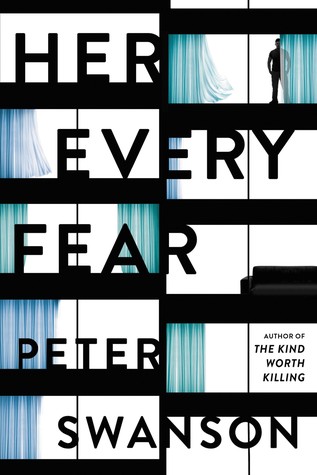
TL; W[on’t]R[ead the review]: Very few twists and turns despite switching pov-chapters, but UGHHHHHH that fucking ending.
Content warnings: murder, semi-graphic body mutilation, extreme misogyny (by murderers), panic attacks, stalking, voyeurism, contemplated animal cruelty (not enacted)
Summary [courtesy of Goodreads]: Growing up, Kate Priddy was always a bit neurotic, experiencing momentary bouts of anxiety that exploded into full-blown panic attacks after an ex-boyfriend kidnapped her and nearly ended her life. When Corbin Dell, a distant cousin in Boston, suggests the two temporarily swap apartments, Kate, an art student in London, agrees, hoping that time away in a new place will help her overcome the recent wreckage of her life. Soon after her arrival at Corbin’s grand apartment on Beacon Hill, Kate makes a shocking discovery: his next-door neighbor, a young woman named Audrey Marshall, has been murdered. When the police question her about Corbin, a shaken Kate has few answers, and many questions of her own—curiosity that intensifies when she meets Alan Cherney, a handsome, quiet tenant who lives across the courtyard, in the apartment facing Audrey’s. Alan saw Corbin surreptitiously come and go from Audrey’s place, yet he’s denied knowing her. Then, Kate runs into a tearful man claiming to be the dead woman’s old boyfriend, who insists Corbin did the deed the night that he left for London. When she reaches out to her cousin, he proclaims his innocence and calms her nerves–until she comes across disturbing objects hidden in the apartment and accidentally learns that Corbin is not where he says he is. Could Corbin be a killer? What about Alan? Kate finds herself drawn to this appealing man who seems so sincere, yet she isn’t sure. Jet-lagged and emotionally unstable, her imagination full of dark images caused by the terror of her past, Kate can barely trust herself, so how could she take the chance on a stranger she’s just met?
I’m beginning to think that Peter Swanson distrusts cis white men as much as I do. After reading Every Vow You Break (and eliminating at least one of his other novels from my TBR list due to some typically ableist thriller tropes), I checked out this book from the library and found myself in yet another world where all of the men (again, with the exception of our heroine’s father, who barely features) are terrible, no good misogynists or at the very least whiny navel-gazing stalkers. I am down for this representation. HOWEVER (and this is a BIG caveat), the very end of the novel undid some of that work for me, and I was unpleasantly shocked at the direction Swanson took things. I’ll get to that in a minute, but first, the non-spoilery stuff.
Judging just from the 2 books of his I’ve read so far, Swanson’s women main characters are a mixed bag, representationally speaking. In this novel, Kate arrives on page having already experienced a thriller/horror novel of her own, having years before escaped a monstrously jealous ex-boyfriend who threatened to murder her before committing suicide, trapping her in a closet for days until she was discovered. Kate ALREADY had an anxiety disorder, so this just added to her belief that bad things were destined to happen to her. Her decision to step out on her own in Boston, far away from her comfort zone in London, is met with a series of escalating threats that would seem to suggest the girl is, as she fears, cursed. Her new next-door neighbor is already dead when she moves in, her cousin becomes the main murder suspect, and another weird neighbor becomes obsessed with her. I appreciated the way the novel handles Kate’s anxiety and the way she copes with new things, both quotidian and shocking, though I do think the plot arc made her much more passive than she could’ve been. In Every Vow You Break, I appreciated how the main character gained agency by the climax of the novel. Here…not so much.
I will say that this novel bears some interesting similarities to Riley Sager’s Final Girls (in terms of its focus on a survivor) as well as Lock Every Door (by focusing on an old, rich apartment complex where things might not be entirely as they seem). Since Sager’s books were themselves indebted to a variety of older texts (Rosemary’s Baby, every slasher film), this says more about the relatively small circle of thriller tropes that will unlock commercial success than anything else. I do remain at a loss as to why these thrillers have to be so white, so cisgender, and so straight, though–are these writers trapped in 1955, at the height of the Hollywood moral code?? (I’m kidding…1955 films snuck way more queer subtext into films than these novels do, though Her Every Fear does some strange things with m/m obsession that I’ll get to in the spoilers.)
One unmitigatedly great thing about this novel, though, is the much-featured cat Sanders, who belongs to a little old lady no one sees but who travels unimpeded throughout the bougie building, from the security desk to our heroine’s apartment. He’s fabulous, and no harm comes to him. (And though a shitty character does think about killing him, in detail, Sanders gets sweet, sweet revenge). I once lived in an apartment complex with a local Sanders (his name was Halo), so I loved seeing this more whimsical element in a somewhat bleak story.

SPOILER TERRITORY
While the novel had some things going for it, the plot really wasn’t one of them. Swanson chose to switch point of view chapters fairly early on, so we rule out murder candidates almost as soon as they’re introduced. It’s pretty obvious early on whodunit, and who that person is currently pretending to be, so I guess that’s not the main mechanism propelling the story. I’m not entirely sure what IS, though, beyond just filling in everyone’s backstory (and I don’t really pick up thrillers with the hopes of finding in-depth character sketches instead). And at the two-thirds mark, we switch to the murderer himself’s perspective, which…man, I did not like that. I don’t want to be in a raving misogynist’s mind, thanks very much. I’ve lived 35 years and have done enough of that, in books, TV, film, games, my damn classroom, you name it.
The one interesting thing to come out of this switched perspective is the “reveal” that the murderer, Henry, is obsessed with his erstwhile murder-partner, Kate’s cousin Corbin. Henry’s never coded as gay or bi–his sexuality is never discussed at all, beyond the fact that he does sleep with women–but he kills first because he wants to punish “cheating” women and then because he wants to maintain his intimate friendship with Corbin. It’s very twisted, but more interesting than your average serial killer plotline. I appreciated that Swanson didn’t let this plotline veer into homophobia OR let Henry’s obsession with Corbin undercut the horrifying misogyny that is the true root of all of the terror in this novel. It was a thin line to walk, but I think he pulled it off. (That being said, I do think much of this novel works as a fairly basic homage to Alfred Hitchcock, from the central Rear Window conceit of the shared building to that bastion of twisted gay tension, Rope.)
Most of the events of the novel happen because of a series of nested stalking attempts by men. Henry stalks Corbin, after Corbin rejects his murder-based best-friendship, which leads Henry to murder Corbin’s secret girlfriend Audrey. Meanwhile, neighbor Alan is a self-admitted peeping tom who has been watching Audrey in her home from his own apartment window for a year. And THEN Alan stalks London-transplant Kate because…he misses Audrey? He is strangely attracted to her? He’s fallen in love with her at first sight? He’s just an inveterate creepwad who can’t stop invading women’s goddamn privacy?? Definitely the last one.
Alan gets his own point-of-view chapters which quickly rule him out as the murderer, and they also attempt to get the reader to sympathize with the man (I think?). He’s very upfront about his stalkerish tendencies, though he does equivocate about them sometimes, and he’s even upfront with Kate about his “history” with Audrey. He skeeved me RIGHT the hell out, so I wasn’t thrilled when Kate instantly felt “at ease” around him and within a few days slept with him. I was expecting a twist similar to Swanson’s most recent novel, in which the ‘nice’ guy turns out to be terrible too, but no such twist came. Kate became anxious after getting so close to Alan and rebuffed him again, but it was his drunken deduction (that Henry-in-disguise had been bitten by Sanders, which meant he’d been hiding in the apartment basement) that led to Kate’s last-minute rescue by the main detective assigned to the case. So Alan was vindicated. Joy.
Even still, I wasn’t expecting the last-act denouement. Kate, having been stabbed in the back by Henry before being rescued, is recuperating in the hospital when Alan, who CAN’T STOP STALKING THIS WOMAN, appears and recites a brief “speech” about how he’s fallen in love with her and wants her to stay in Boston and give their relationship a chance. I was appalled. But Kate stands up for herself and decides she wants to be independent (cool), so she takes a vacation to Provincetown to deal with her anxiety. While there, she realizes she DOES want a relationship, and she rushes back to Boston and falls into Alan’s arms.
Um…WTF?? When I tell you I was beyond grossed out…It reads like a bad YA novel, where the creepy, sparkly boy gets the girl, but in this case they’d only known each other for FOUR DAYS and she’d spent most of it panicking about a murder. No thank you.
I mean, this IS a terrifying ending, ironically speaking, but I think it was meant to be happily-ever-after? I do wonder if this is the reason Swanson went so hard on his ‘yes all men’ novel this year, though. After this garbage, it’s the least he could do.
Copaganda rating: Medium (The cops show up sporadically, and the main detective is very competent and kind and ‘saves the day’ in the end. Also, the narrative takes pains to stress that when she shoots the main murderer in the head, it’s the first time she’s ever discharged her weapon at a person. It also stresses that she’s disturbed by the action, even if it saved the main character’s life. I feel like so many thrillers take a ‘lady cops are smart and good and noble’ tack that…is not the feminist take they think it is. [Hello CJ Tudor.])
